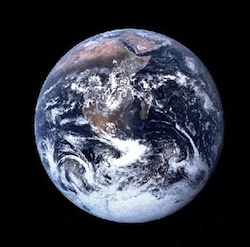
Kaluza, Klein and their story of a fifth dimension
In the latest poll of our Science fiction, science fact project you told us that you wanted to know how many dimensions there are. Here is the first part of theoretical physicist David Berman's answer (you can read the second part here). Click here to see other articles exploring this question and here to listen to our interview with Berman as a podcast.
What is a dimension?
What do we mean by "dimension"? An intuitive description of dimensions is that it's the ways in which we can move – up and down, left and right, forward and backwards – which leads us to believe we live in a three-dimensional world.

35th Street and 10th Avenue – a two dimensions address in New York.
Let's think about what this means in terms of giving someone an address. You can specify where you are in two dimensions. For example in New York you'd say "on 35th Street and 10th Avenue", a simple two dimensional address of how many blocks north-south and how many blocks east-west you are.
But what if you are on a particular floor of a tall office block? Then you'd have to say "5th floor, on 35th Street and 10th Avenue". You have specified three things – how far north or south, how far east or west, and how far up – so you have given three coordinates, specifying a point in three-dimensional space.
In fact we are used to living in four dimensions. If you are arranging a meeting then you need to give one more piece of information: the time of the meeting, say 3pm. With four coordinates you can describe any event. We don't tend to clump time with the spatial dimensions but if you think about it, any event really happens in a spacetime with four dimensions. You can measure differences in time just like you can measure differences in space – we measure differences in space with a ruler and we measure differences in time with a clock. So anything you can think of in terms of space you can think of in terms of time.
We can learn a lesson from this: our human perception of dimensions is limited. We only perceive three dimensions. We can understand that time is an extra dimension, an extra location for any event, but we don't see time in the same way. We experience it very differently from spatial dimensions as human beings. This hints that human perceptions of things may not be the end of the story in terms of what's possible.

A point in 16-dimensional space
Mathematically the number of dimensions is just the number of coordinates you need to specify a point. We're familiar with specifying points in four-dimensional spacetime, but can you imagine a space where you need five bits of information? Or six? Or seven…? Mathematicians regularly work in higher dimensional spaces, but they are not the only ones. For example if you're a sound mixer making music you might be working with 12, 24, or even 128 tracks. At each moment in the music each of the, say, 24 tracks has a specific volume, defining a point in a 24-dimensional space of sound. The number of dimensions is just the number of bits of information you need to specify a point.
Curved and hidden
Einstein famously combined the three spatial dimensions with additional dimension of time into four-dimensional spacetime. But at around the same time the German mathematician Theodor Kaluza and the Swedish physicist Oskar Klein began to wonder if there were more than three spatial dimensions.
General relativity, which was Einstein's big idea, said that dimensions could be curved. This sounds strange at first but we are used to that as well. The surface of the Earth is two dimensional and it's curved. We specify a location on the surface of the Earth using two coordinates: longitude and latitude. But these coordinates are periodic – you can come back to yourself if you travel 360 degrees around the Earth. The surface of the Earth is a two-dimensional surface inside a three-dimensional space.
Kaluza and Klein wondered if physical space could be curved in a similar way. That particular dimensions don't go on forever in space but the dimensions of space itself could be so curved that space comes back on itself like a circle.

We're already used to curved dimensions – the two dimensional surface of the Earth is curved with periodic coordinates.(Image from NASA)
That sounds a bit weird: could you go off in your rocket ship in a particular direction and then arrive back where you started, just like circling the earth in a plane? Would we notice these curved dimensions?
This would depend on the size of the circle around which the dimension curves. If the circle was, say a hundredth or a thousandth the size of an atom, then that is so small you probably wouldn't even notice the presence of that dimension. Imagine rolling up a piece of paper very tightly into a cylinder with a tiny diameter – from a distance you wouldn't notice that it was a cylinder at all, it would look just like a line.
Thinking in terms of coordinates, this would be just like when giving an address in three-dimensional space using only two pieces of information. If my house is located at, say, 4th and 5th streets, and is one step up from the road, I don't normally specify that because it won't really be noticed. If you're travelling four streets one way and five streets another and you come to the house and it's 10 centimetres above the ground because of some tiny step, it's irrelevant to the big picture.
Kaluza and Klein proposed that you could have one extra spatial dimension but if that dimension was curled up into a circle with a very small radius, smaller than any other scale that was around, then you wouldn't notice it.
Gravity in the fourth dimension
So why should we care about an extra dimension if you can't even notice it? Kaluza and Klein showed, using general relativity, that this extra dimension would still have an effect on the space around us. In particular they showed that the effect of gravity in that very small fifth dimension would actually appear to us, from our larger-scale perspective, as electromagnetism.
This Kaluza-Klein Theory had many fascinating consequences. Things that have charge under electromagnetism would just be things that are moving in this circular fifth dimension. The radius of this extra dimension would be related to the electric charge of particles. A charged particle would move in one direction in the fifth dimension, and an oppositely charged particle would move in the other. And as the momentum of two oppositely charge particles would cancel out when they collide, they would no longer move in the fifth dimension making their combined charge neutral.
Although Kaluza and Klein's theory seemed to unify the forces of electromagnetism and gravity it wasn't widely accepted when it was published in 1921. It was mathematically true but the concept of extra spatial dimensions seemed very strange. However some 60 years later this mathematical oddity provided a missing piece in the hunt for quantum gravity…
Read more in the next article: The ten dimensions of string theory.
About the author

David Berman is a Reader in Theoretical Physics at Queen Mary, University of London. He previously spent time at the universities of Manchester, Brussels, Durham, Utrecht, Groningen, Jerusalem and Cambridge as well as a year at CERN in Geneva.
His interests outside of physics include football, music and theatre and the arts.
Comments
Anonymous
Thankyou for this article. Very interesting and clearly written. May I suggest a proofread as there are several mistakes which distract from the polish and may confuse a reader for whom English is not their native language.
Marianne
Thanks for pointing this out, we will check the article.
tal
in sentence below, there are extra verbs to remove, due to proper english."Things that have charge under electromagnetism (are) would just be things that are moving in this circular fifth dimension. The radius of this extra dimension would be related to the electric charge of particles. A charged particle would (be) move in one direction in the fifth dimension" removing the two words verbs are and be as marked/
CRD
Excellent article. I did not notice any mistakes at all...
qwondre
That's because you are in the future!